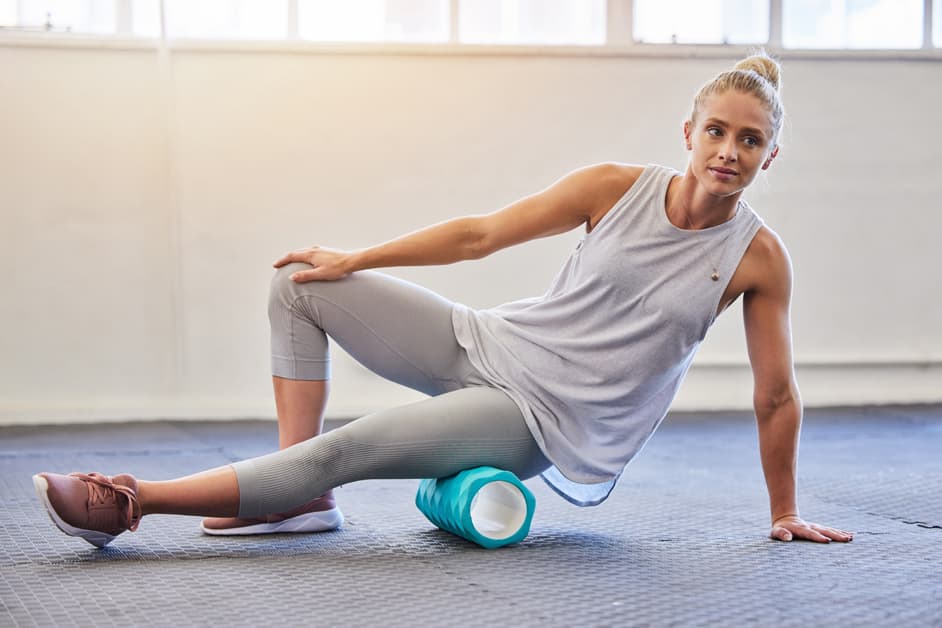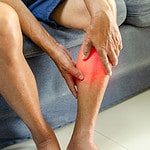Introduction
Foam rolling is a form of self-myofascial release (SMR). It can improve mobility, increase circulation and relieve pain. Knee pain can be treated using this non-invasive method. Applying pressure with a foam roller gives a deep muscle massage. This reduces inflammation and tension, while also promoting healthy circulation in the joint, muscles and ligaments.
This therapy is great for those with chronic joint pain from conditions such as arthritis or tendonitis. Foam rolling may even improve knee joint stability.
In this guide, we’ll discuss the benefits of foam rolling for knee pain relief. Plus, we’ll give tips for using a foam roller correctly. And, the importance of seeking medical advice if symptoms persist beyond 48 hours.
What is Foam Rolling?
Foam rolling is a form of self-myofascial release (SMR). It’s an alternative therapy to treat acute and chronic pain in connective tissue, known as fascia. Roll a cylindrical foam roller over tense areas in the body. The aim is to reduce tension, break down scar tissue, improve circulation, and increase flexibility and range of motion.
The foam roller applies slow and deep pressure to the fascia. This targets localized areas and releases tension that can cause discomfort or restrict movement. It breaks up adhesions in tight muscles by repetitively “massaging” them with your own body weight. Foam rolling should be comfortable with only some light discomfort.
Foam rolling is especially beneficial for people with knee pain. It targets chronically tight muscles around the knee joint. This can lead to joint dysfunction causing pain. Rolling on the quadriceps, calf muscles, hamstrings, glutes and IT bands can help reduce stiffness in these muscle groups. It helps restore normal joint range of motion around the knee. Benefits include improved alignment, pain relief, increased flexibility, and better circulation throughout the lower body. It’s an ideal option for anyone looking for natural options for chronic knee pain relief.
Benefits of Foam Rolling
Foam Rolling is rad! It’s a low-cost, low-risk activity. It can reduce muscle tension and help to relieve knee pain. It can also reduce inflammation, improve circulation, and provide physical relief from the pain of arthritis, tendinitis, and more.
Let’s check out how it can help with knee pain!
Improved Circulation
Foam rolling improves circulation in muscles. It helps to recover faster from muscle soreness due to exercise. It also reduces knee pain. Pressure from the roller boosts blood flow and lymphatic drainage. This helps to remove toxins and other fluids responsible for soreness and inflammation. Better circulation means better oxygen for cells, which leads to better muscle health. This can even help joint health in the knee, and reduce recovery time after injury or intense activity. Plus, the roller helps break down adhesions between muscles, helping to reduce pain and improve flexibility and range of motion.
Reduced Muscle Tension
Foam rolling has many benefits. It helps reduce muscle tension, which can happen when you exercise, start a new workout program, or twist an ankle. You can target specific areas and roll them out quickly. This can help with discomfort, improve mobility and flexibility, and reduce future injuries.
It also helps increase blood flow, pushing fluid back into dormant muscles and breaking down lactic acid. This is especially helpful for knee issues like tendonitis, bursitis, arthritis, and PFS.
Increased Range of Motion
Foam rolling is a great way to boost your exercise routine! It helps break down adhesions in the fascia tissue, meaning that your joints and muscles can move with more range of motion. You’ll be able to move without restriction, so you can perform better in any activity. With increased flexibility, you’ll experience increased strength and power.
Foam rolling can be especially beneficial for knee pain. It targets the hamstrings, quads, and other soft muscle areas around the knee, releasing tension and leading to an increase in range of motion. Don’t just focus on problem areas – the whole body benefits from regular foam rolling, as it helps with both mobility and stability across total body movement patterns.
Reduced Inflammation
Foam rolling is an effective way to reduce inflammation and its effects. Regular rolling can cause less soreness, less joint pain, improved range of motion, and better joint health. It does this through massage, which increases blood flow to the area, reducing inflammation.
Foam rolling also helps with fascia build-up from activities, like sitting or standing for a long time. The fascia anchors muscles and can misalign them if it gets too tight. Rolling helps reduce tension in the tissue and improves alignment and flexibility.
It also helps healing and recovery time between workouts, so athletes feel less fatigue during training, leading to fewer injuries and better performance.
How to Foam Roll
Foam rolling is a great option for those with knee agony. It’s a self-massage technique that you can do from your home. To experience max relief from knee pain, let’s learn how to foam roll safely and correctly:
Start with a Light Roll
Foam rolling, or self-myofascial release, is a popular fitness tool. For knee pain specifically, it can desensitize tight muscles, and improve range of motion. It can also reduce inflammation in the knees and relax tense areas.
To use a foam roller on your knees, start with 10-15 reps for 30 seconds each. Focus on areas around your hips and thighs. When you come across tender spots or knots, use more pressure to release trigger points until the tenderness subsides. Going over these areas again at different angles helps break down tightness and keep the area flexible.
Move in a Slow, Controlled Manner
Roll slow, and controlled. Foam rolling relaxes the fascia, as well as the muscles. Rolling too fast may make tension worse, not better.
Start at the top of your body, and move downwards. Keep your body straight while rolling – this helps with circulation and prevents strain. Keep your core engaged. Hold the pressure for 15-30 seconds. This way, you get the most relief from your roll session.
Foam Roll with Intention
Foam rolling is more than just rolling back and forth. Focus on your body, your breath, and the pain you feel. With intention, foam rolling can help relieve knee pain. Here are some tips to get the most out of your exercises:
- Find an area that is tight and put the roller there.
- Roll in a slow and controlled movement, not too hard (8/10 on a scale of 10).
- Do multiple sets rather than one big one.
- Focus on those areas for up to 2 minutes; this helps with mobility and releasing tension.
- Drink water before and after foam rolling; this helps flush out any toxins.
Conclusion
Foam rolling is an affordable and easy-to-do activity. It can be used to reduce knee pain and help with flexibility and mobility. However, it is best to talk to your healthcare provider before starting any new exercise program or trying something new.
Foam rolling may provide temporary relief from knee injury pain. It can be a great tool to add to your workout plan if you are dealing with discomfort in the knees.
Frequently Asked Questions
Q1: What is foam rolling?
A1: Foam rolling is a type of exercise and massage technique that uses a cylindrical foam roller to roll out areas of tightness in the muscles and soft tissues.
Q2: How does foam rolling help with knee pain?
A2: Foam rolling helps to increase blood circulation to the muscles and soft tissues around the knee, which helps to reduce pain and stiffness. It also helps with range of motion and flexibility, which can help reduce knee pain.
Q3: How often should I foam roll for knee pain relief?
A3: For best results, foam rolling should be done at least twice a week for 10-15 minutes each session.





